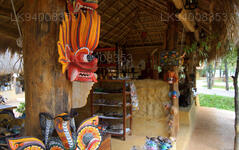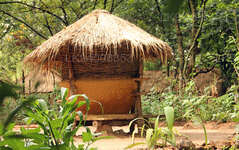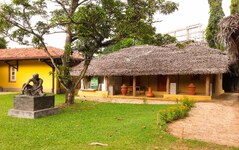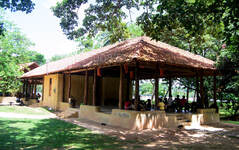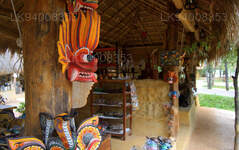
Città di Colombo
Colombo, la capitale dello Sri Lanka, è una città dinamica che fonde tradizione e modernità. Vanta un'architettura coloniale, vivaci mercati e sereni templi buddisti. Con una cucina variegata, uno skyline in continua crescita e splendide spiagge, è un vivace centro per gli affari, la cultura e il turismo, offrendo un punto di partenza ideale per esplorare le meraviglie dello Sri Lanka.
Ape Gama (Our Village; අපේ ගම)
Ape Gama in Sri Lanka: Historical theme Park
Ape Gama in Sri Lanka is a replica of traditional old day Sri Lankan village. This is located in Battaramulla, close to “Diyatha Park”. Ape Gama displays traditional industries, village life style and how self-sufficient old day Sri Lankan society functions in those days.
Formerly, this spot was known as the “Battaramulla Janakala Kendraya” that showcased local crafts. The entire area was revamped for the Commonwealth Heads of Government Meeting (CHOGM) in 2013 to exhibit the fascinating aspects of historic Sri Lankan village life, complete with a bird-watching zone and a mini zoo.
The outstanding recreation of life in a Sri Lankan village has been achieved with precision and attention to detail. It’s not too far from Colombo, situated at the Jana Kala Kendraya in Battaramulla. From the well kempt garden to the many houses made of mud enclosed with wattles, to the figurines of men and women in many postures, the concept has been brought to fruition with much meticulousness. The simplicity and plainness that typifies village living is showcased in all the exhibits.
“Ape Gama in Sri Lanka” attracts throngs of visitors each week seeking a short break in a unique venue.
Ape Gama in Sri Lanka: Village life
Ape Gama is open 365 days of the year from 9 am to 9 pm. And its folk are standing by to explain the many facets of village life. Yes, there are people living in this ‘model’ village attending to everyday tasks for visitors to observe. Karunarathne Mahagamarala is the Headman of this village.
Ape Gama has been constructed as a replica of the old village in Sri Lanka. All the houses are built in a circular form with a ‘meda midula’ or garden at the centre. This is where children used to gather for play while the village was protected along its periphery by the houses. Women folk of Ape Gama are quite busy making and selling Sri Lankan sweetmeats.
A cooking demonstration of sorts take place as women keep themselves busy frying sweets in one pan while sugar and grated coconut is being cooked in another. The demand for these fresh sweets is quite high and the small village ‘boutique’ is finding it difficult to cope with the swelling customers. Women are walking hurriedly to and fro taking the prepared sweets for sale. Visitors finish it off with a cup of herbal drink served in coconut shells. In the meantime the drummer is making music and song seated in the porch of his house.
The houses are separated by fences made of twigs and in some places a narrow bridge made with the trunk of a coconut tree leads to the garden. Varieties of vegetables are grown along the fences. The village is surrounded by trees and tall grass; in one corner of the village is a tree house from where the farmer protects his crops at night.
Ape Gama in Sri Lanka: Arts and Crafts
Beyond Ape Gama is an extension of ‘Sri Lankness’ with many craft houses selling products typically Sri Lankan. The concept is based on creating open spaces just like Ape Gama. Craftsmen work in their outlets making jewellery, carving masks and statues, painting fabric, sewing, making lace and more.
Some of these have been in existence as cottage industries for years and survived for generations. The difference today may be the use of technology and technique, but the elegance remains unchanged. The visitor must take time to go through these craft houses as there is so much to take in.
Ape Gama in Sri Lanka: Visitor Reviews
"It is a very good place for 5th grade school children and for foreigners those who love to see and experience the traditional Sri Lankan lifestyle. The Village Man will explain about the lifestyle and ancient Sinhala vocabulary by giving examples in an interesting manner. Can be experience live clay pot making, wood carving techniques, handmade items along with the..." – Visited January 2017
"Within the park there is Ape Gama a representation of how Sri Lankan villages used to look and operate. There are some classic buildings showing the skill of previous generations in building shelters from the environment. The village is well laid out and easy to stroll around." – Visited April 2016
"Nice paths and scenery to walk around on a nice day. Paths are surrounded by pools of water which look almost natural. Large and small fish can be seen in the water surrounding the paths, but there is a small range of Aquariums nearby filled with several fish. In addition to the small shops (which do not force you to buy stuff) selling plants and aquarium fish, there is also a food stall with a selection of different food to eat."
Informazioni sul distretto di Colomb
Colombo è la città più grande e la capitale commerciale dello Sri Lanka. Si trova sulla costa occidentale dell'isola e adiacente a Sri Jayewardenepura Kotte, la capitale dello Sri Lanka. Colombo è una città vivace e trafficata, con un mix di vita moderna, edifici e rovine coloniali e una popolazione di 647.100 abitanti. La regione metropolitana di Colombo, definita dai distretti di Colombo, Gampaha e Kalutara, ha una popolazione stimata di 5.648.000 abitanti e si estende su una superficie di 3.694,20 km². Colombo è una città multietnica e multiculturale. È la città più popolosa dello Sri Lanka, con 642.163 abitanti che vivono entro i confini della città. La popolazione di Colombo è un mix di numerosi gruppi etnici, principalmente cingalesi, mori e tamil. In città vivono anche piccole comunità di persone di origine cinese, portoghese, olandese, malese e indiana, oltre a numerosi espatriati europei. La stragrande maggioranza delle aziende dello Sri Lanka ha sede a Colombo. Alcuni dei settori industriali includono prodotti chimici, tessili, vetro, cemento, pelletteria, arredamento e gioielleria. Nel centro città si trova il secondo edificio più alto dell'Asia meridionale: il World Trade Center.
Informazioni sulla provincia occidentale
La Provincia Occidentale è la provincia più densamente popolata dello Sri Lanka. Ospita la capitale legislativa Sri Jayawardenepura Kotte e Colombo, il centro amministrativo e commerciale della nazione. La Provincia Occidentale è divisa in 3 distretti principali: Colombo (642 km²), Gampaha (1.386,6 km²) e Kalutara (1.606 km²). Essendo il fulcro economico dello Sri Lanka, tutte le principali aziende locali e internazionali hanno sede in città, così come i principali negozi di stilisti e grandi magazzini, quindi preparatevi a concedervi un po' di shopping nella Provincia Occidentale. Avendo la popolazione più alta di tutte le province, quasi tutti i principali istituti scolastici dell'isola si trovano nella Provincia Occidentale. Le università della provincia includono l'Università di Colombo, l'Università di Sri Jayewardenepura, l'Università di Kelaniya, l'Università Aperta dello Sri Lanka, l'Università Buddista e Pali dello Sri Lanka, l'Università della Difesa Generale Sir John Kotelawala e l'Università di Moratuwa. La provincia occidentale ospita il maggior numero di scuole del paese, tra cui scuole nazionali, provinciali, private e internazionali.

